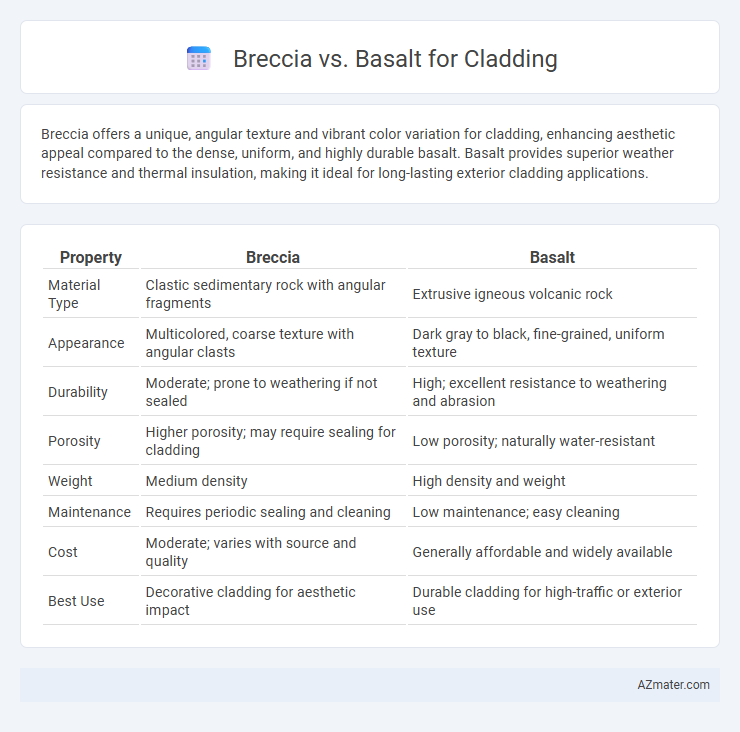Breccia offers a unique, angular texture and vibrant color variation for cladding, enhancing aesthetic appeal compared to the dense, uniform, and highly durable basalt. Basalt provides superior weather resistance and thermal insulation, making it ideal for long-lasting exterior cladding applications.
Table of Comparison
| Property | Breccia | Basalt |
|---|---|---|
| Material Type | Clastic sedimentary rock with angular fragments | Extrusive igneous volcanic rock |
| Appearance | Multicolored, coarse texture with angular clasts | Dark gray to black, fine-grained, uniform texture |
| Durability | Moderate; prone to weathering if not sealed | High; excellent resistance to weathering and abrasion |
| Porosity | Higher porosity; may require sealing for cladding | Low porosity; naturally water-resistant |
| Weight | Medium density | High density and weight |
| Maintenance | Requires periodic sealing and cleaning | Low maintenance; easy cleaning |
| Cost | Moderate; varies with source and quality | Generally affordable and widely available |
| Best Use | Decorative cladding for aesthetic impact | Durable cladding for high-traffic or exterior use |
Introduction to Breccia and Basalt Cladding
Breccia cladding, composed of angular rock fragments cemented together, offers a unique textured and multicolored appearance ideal for accent walls and architectural features. Basalt cladding, formed from fine-grained volcanic rock, provides a sleek, durable, and weather-resistant surface commonly used for modern building facades. Both materials deliver distinct aesthetic and functional benefits, with breccia emphasizing natural patterns and basalt showcasing uniformity and strength.
Geological Origins: Breccia vs Basalt
Breccia is a sedimentary or volcanic rock composed of angular fragments cemented together, originating from the accumulation of broken rock fragments often near fault zones or volcanic eruptions. Basalt is a dense, fine-grained igneous rock formed from the rapid cooling of low-viscosity lava flows on the Earth's surface, commonly found in volcanic regions and oceanic crusts. The geological origins of Breccia impart a textured, fractured appearance ideal for decorative cladding, while basalt's uniform, fine-grained structure provides a durable, weather-resistant surface well-suited for structural and aesthetic applications.
Aesthetic Differences: Texture and Appearance
Breccia cladding offers a distinctive, fragmented texture with angular rock fragments cemented together, creating a dynamic and irregular pattern that enhances visual interest. Basalt cladding features a uniform, fine-grained texture with a consistent dark gray to black color, providing a sleek and modern appearance. The contrasting aesthetics between Breccia's textured complexity and Basalt's smooth uniformity allow architects to choose based on desired visual impact and design style.
Physical Properties and Durability
Breccia and basalt differ significantly in physical properties and durability for cladding applications. Breccia, composed of angular fragments cemented together, offers varied texture and color but generally exhibits lower density and strength compared to basalt. Basalt's fine-grained, volcanic origin provides higher compressive strength and exceptional resistance to weathering, making it more durable and suitable for exterior cladding exposed to harsh environmental conditions.
Color Variation and Design Flexibility
Breccia offers dramatic color variation with its fragmented composition of varied minerals, creating unique patterns ideal for high-end, artistic cladding designs. Basalt presents a more uniform, deep gray to black hue, providing sleek, modern aesthetics with consistent color throughout the material. The design flexibility of Breccia caters to eclectic and vibrant architectural styles, while Basalt suits minimalist and contemporary projects requiring subtle sophistication.
Installation Challenges and Techniques
Breccia cladding requires precise handling due to its irregular fragments and variable thickness, making cutting and aligning more complex compared to the uniform structure of basalt. Basalt panels offer easier installation with consistent dimensions and enhanced durability, reducing the risk of cracking during mounting. Specialized tools and skilled labor are essential for breccia to ensure secure anchoring and maintain aesthetic integrity, whereas basalt allows for faster installation using standard stone fixing techniques.
Maintenance and Long-Term Performance
Breccia offers high resistance to weathering and minimal maintenance due to its natural durability and porous surface, making it ideal for long-term cladding applications. Basalt provides exceptional strength and low water absorption, which contributes to its longevity and resistance to staining, reducing cleaning frequency over time. Both materials ensure sustained aesthetic appeal and structural integrity, but basalt typically requires less upkeep in harsh environments.
Environmental Impact and Sustainability
Breccia, composed of angular rock fragments, typically requires less energy for extraction and processing compared to basalt, reducing its overall carbon footprint in cladding applications. Basalt, a dense volcanic rock, offers high durability and thermal mass, contributing to long-term energy efficiency in buildings and enhancing sustainability through reduced maintenance and replacement frequency. Both materials are natural stones with minimal chemical treatments, but the local availability of breccia or basalt significantly influences transportation emissions, making site-specific selection crucial for environmentally responsible cladding.
Cost Comparison: Breccia vs Basalt
Breccia generally incurs higher installation and material costs compared to basalt due to its complex veining and unique patterns that require more precise cutting and handling. Basalt, being more abundant and uniform, offers a more cost-effective solution for large-scale cladding projects without compromising durability or aesthetic appeal. When evaluating long-term value, basalt's lower maintenance and installation expenses often make it the preferred choice for budget-conscious cladding applications.
Best Applications for Each Stone in Cladding
Breccia offers unique visual appeal with its angular fragments and varied colors, making it ideal for decorative cladding in luxury interiors and accent walls where aesthetic impact is paramount. Basalt provides exceptional durability, thermal resistance, and a sleek, uniform appearance, making it suitable for exterior cladding on commercial buildings and high-traffic areas requiring weather resistance and structural strength. Both stones excel in cladding but differ in optimal application: Breccia suits ornamental and interior projects, while Basalt is preferred for robust, functional exterior facades.

Infographic: Breccia vs Basalt for Cladding
 azmater.com
azmater.com